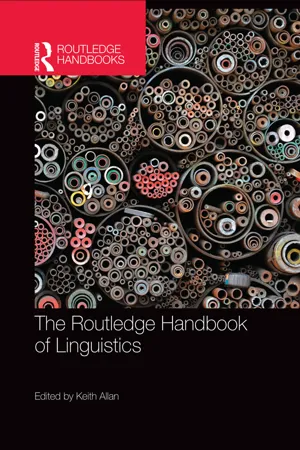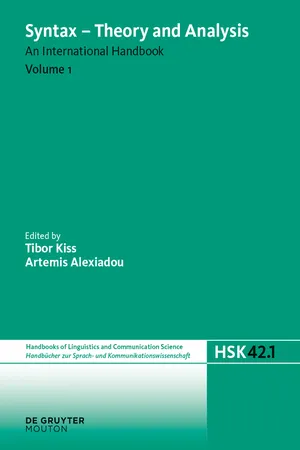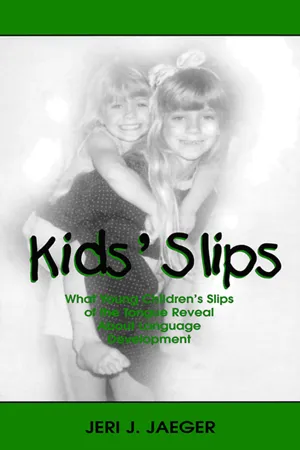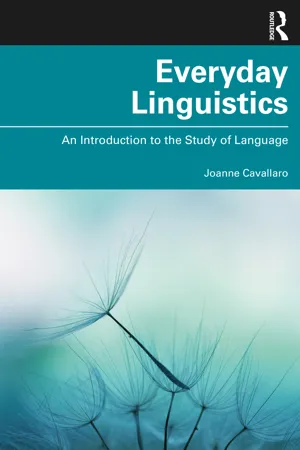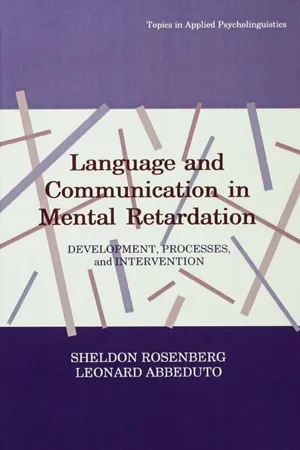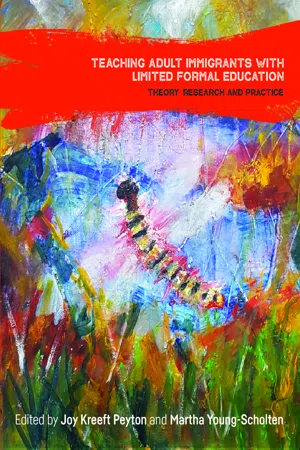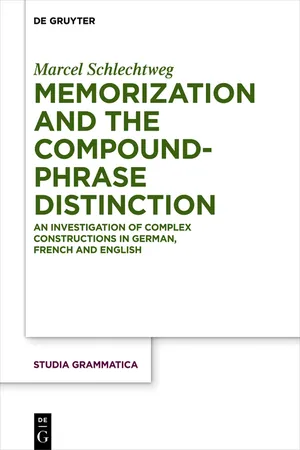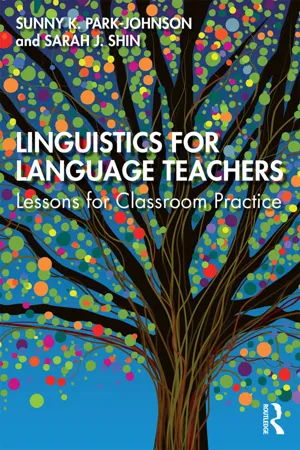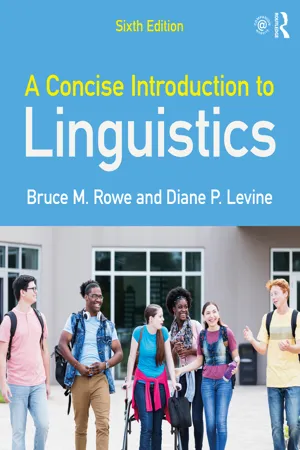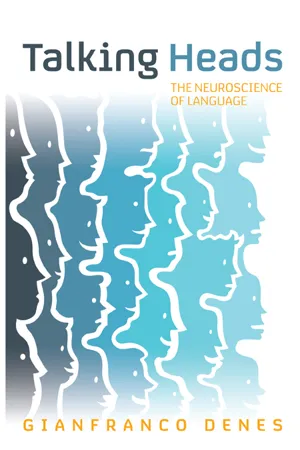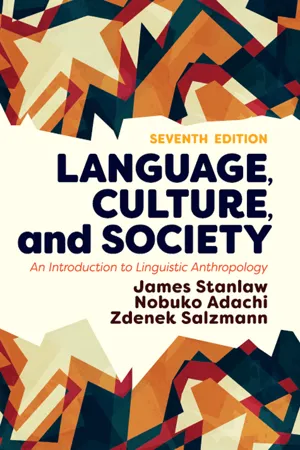Languages & Linguistics
Morphosyntax
Morphosyntax is the study of the relationship between the structure of words and the structure of sentences in a language. It examines how words are formed and how they are combined to create meaningful sentences. This field of linguistics focuses on the morphological and syntactic aspects of language, including word formation, inflection, and sentence structure.
Written by Perlego with AI-assistance
Related key terms
Related key terms
1 of 4
Related key terms
1 of 3
12 Key excerpts on "Morphosyntax"
- eBook - ePub
Sign Languages
Structures and Contexts
- Joseph Hill, Diane Lillo-Martin, Sandra Wood(Authors)
- 2018(Publication Date)
- Routledge(Publisher)
Chapter 3Morphology
In this chapter, we continue our discussion of sign language grammar, turning to the domain of morphology . Morphology is the study of words, so in this chapter, we will look at how words are made in American Sign Language (ASL). We will discuss the ways that new words are formed, how words are modified, and the role of iconicity in ASL. The chapter also includes discussion of the way that the signing space is integrated in signs, and some morphological devices that seem to be special to sign languages.3.1 What is morphology?
Morphology is the branch of linguistics that studies how words are formed from component parts. A morpheme is generally described as a consistent pairing of form (e.g., a sequence of sounds or a combination of handshape, location, and movement) and meaning, but there are morphemes that change their form in different contexts as well as those that don’t seem to have a consistent meaning.In spoken languages such as English, there are many words that are themselves a single morpheme, such as “cat,” “elephant,” “and,” and “behind.” Bear in mind that in English, a morpheme can have one, two, or more syllables – they are completely different notions. Words that contain two morphemes include “cats,” “walking,” and “rewrite.” The plural marking -s on “cats,” the progressive -ing on “walking,” and the prefix re- in “rewrite” contribute an additional morpheme that either makes a word fit a particular context (the usual role of inflectional morphology), or changes the word into a new type with a new meaning (the usual role of derivational morphology). In addition to inflectional and derivational morphology, word formation is a component of morphology. Word formation encompasses the various ways that new words are added to a language. We will discuss sign language examples of each of these types of morphology in reverse order in the subsequent sections. - eBook - ePub
- Keith Allan, Keith Allan(Authors)
- 2015(Publication Date)
- Routledge(Publisher)
lunch .7.3 The place of morphology in grammar
The position of morphology in the architecture of the grammar of natural languages has been debated for decades in the linguistic literature, and it is impossible to summarize this debate in detail in this chapter.In a syntactic approach, morphology is defined as the ‘syntax of morphemes’ and the way in which morphemes are combined is accounted for by the same syntax that accounts for the construction of sentences from words. The most recent form of this approach is the theoretical framework of Distributed Morphology (Harley and Noyer 1999; Marantz 2013).In the lexicalist approach to word formation, on the other hand, there is a separate morphological component in the grammar that accounts for word formation, and precedes the syntactic component that serves to combine words into grammatical sentences. This component enriches the lexicon of a language which provides the words that can be used in the construction of sentences. The inflectional forms of a word may be generated pre-syntactically, or post-syntactically. In the first option, the proper inflectional form of a word in a particular syntactic context is selected by syntactic rules such as agreement rules; in the second option, the stem of words is selected for lexical insertion into syntactic structure, and this stem is then operated upon by the post-syntactic rules of inflection. For instance, the verb form sings in My father sings wonderfully is either selected as the proper form (third person singular present tense) by the rule of Subject–Verb agreement, or this rule assigns the features [third person singular] to the present tense stem sing , and this configuration is then spelled out as sings - eBook - ePub
- Tibor Kiss, Artemis Alexiadou, Tibor Kiss, Artemis Alexiadou(Authors)
- 2015(Publication Date)
- De Gruyter Mouton(Publisher)
The causative construction has been the focus of much research and its study continues to raise issues of importance. This and other data concerning the realization of arguments are key to understanding and defining the relationship between lexical items and syntax. A closely related issue is the interface between syntax and morphology.3. Syntax and morphology
3.1. Introduction
Different theoretical approaches account for the part which syntax plays in the formation of complex words in distinct ways. Defining the nature of morphology is an important consideration in itself. A key proposal that cuts across lexical and syntactic approaches to the syntax−morphology interface is the Separationist Hypothesis (see Beard 1995, amongst others), which advocates divorcing the meaning or morphological function of a morpheme from its form. For example, an abstract L(exical)-derivation rule of pluralization changes the features of an English singular count noun thus: [−Plural, +Singular] → [+Plural, −Singular] (Beard 1995: 160). The form of the plural is determined in a separate morphological spelling (MS) component. MS-rules include suffixation, e.g. dog−dogs , and umlaut, e.g. man−men , which accounts for the multiple exponence of the morphosyntactic category ‘plural’ in English. This approach is often adopted in the analysis of inflection, and has also been extended to derivation by some researchers (see Beard 1998).For those who do not subscribe to the view that syntax subsumes morphology (Section 3.2 ) and instead adhere to a strong or weak version of the Lexicalist Hypothesis (Section 3.3 ), the challenge is not only to identify those primitives and operations which are uniquely morphological in their nature and define them, but also to characterize the interface between syntax and morphology (Section 3.4 - eBook - ePub
Kids' Slips
What Young Children's Slips of the Tongue Reveal About Language Development
- Jeri J. Jaeger(Author)
- 2004(Publication Date)
- Psychology Press(Publisher)
Chapter 6 Morphology and Syntax 6.1 IntroductionIn the preceding chapters I have frequently discussed issues which are pertinent to the representation and processing of morphology and syntax, and the development of these aspects of language structure. The purpose of the present chapter is to look in more detail into a set of specific questions regarding the development of the representation and processing of morphology and syntax, which will partially be related to previously discussed issues but will also involve new questions. At the end of the chapter I will summarize the aspects of Morphosyntax about which SOT data provide developmental evidence.6.2 The Morphological Structure of Lexical EntriesIn previous chapters I have taken a very specific stance regarding the morphological make-up of lexical entries, and the relationship between inflectional morphology and syntax in English. Specifically, I have argued that in English, multi-morphemic words, including derived forms, compounds, and particle verbs, are stored in the lexicon as single entries, but regularly inflected forms are not. Rather, the inflectional affixes themselves are stored as individual lexical entries, and stems + affixes are concatenated on-line during processing. During speech production planning, inflectional morphology is closely related to syntactic frames rather than lexical items. On the other hand, irregularly inflected forms are stored in the form lexicon, linked with the forms of their stems. This model is similar to the models called ‘dual-route’ in the literature (see Pinker 1991, Pinker & Prince 1988, 1991), and fits with the ‘stages’ type processing models, such as those of Fromkin (1973a), Garrett (1980a, 1993), Levelt (1989, Bock & Levelt 1994), and the RPC Model introduced in Chapter 1 - eBook - ePub
Everyday Linguistics
An Introduction to the Study of Language
- Joanne Cavallaro(Author)
- 2023(Publication Date)
- Routledge(Publisher)
CHAPTER 3 Morphology Word histories and structureDOI: 10.4324/9780429269059-3First glance- How do we put words together?
- Word formation processes:
- · When is borrowing theft?
- Word structure: Morphemes
- Derivational and inflectional morphemes
- Grammatical meaning
- Morphology in other languages
- Hierarchical structure of words
- Acquiring words
INTRODUCTION
Most people probably think of words as the basic, most important part of a language. When we learn a foreign language in school, aren’t we asked to memorize all those words at the end of each chapter? If we do memorize them, we’re often not much further along in learning to speak the language, though, because every language consists not only of a lexicon—a vocabulary—but also a phonological system, a morphological system, a syntactic system, and a grammar for putting them all together. Each system has a structure that we’ll examine in the following chapters. Here we’ll start with those words by examining morphology, the study of words and their structure.What is it we know when we know a word? We know its meaning or meanings, its pronunciation or sign, how it’s used in a sentence, and how to use it appropriately. We know that, even within the same language, the word for something in one area may be totally different in another area. A submarine sandwich (or sub) in Minnesota, for example, is a hoagie in Philadelphia and a hero in San Francisco. We know that words vary across time as well as space; that is, they come and go. How many of you still speak of an ice box, a davenport, or consumption (refrigerator, sofa, and tuberculosis, respectively) or use slang terms like groovy or phat or rad?We know, even if we’re not aware of it consciously, that words are made up of separate parts that have meaning. Doors, for example, is made up of two parts, door and an {s} that means it is plural. We also know that each word is a particular part of speech (a noun or a verb, for example), what linguists call lexical categories - eBook - ePub
Language and Communication in Mental Retardation
Development, Processes, and intervention
- Sheldon Rosenberg, Leonard Abbeduto(Authors)
- 2013(Publication Date)
- Psychology Press(Publisher)
5 Morphosyntactic DevelopmentMorphosyntax (i.e., syntax and morphology) is at the center of language competence. It is the vehicle for the expression of semantic relations and dependencies between semantic relations (in complex sentences), the major source of the infinite combinatorial capability of language users, and the strongest candidate for an innate specifically linguistic component in language acquisition (e.g., Chomsky, 1986). In chapter 2 , we discussed various aspects of linguistic competence and their acquisition in nonretarded individuals and introduced the reader to the three major theories of language acquisition. On the basis of the material in question, a number of claims can be made concerning language acquisition in typically developing persons that are relevant to the study of morphosyntactic development:- Children are able to acquire any human language. Thus, any account of language acquisition must take into account the ease with which children can zero in on characteristics of the local language.
- Language acquisition takes place on the basis of limited input in a relatively short period of time, with no special training and what appears to be limited or no negative feedback concerning errors.
- To a large extent, language acquisition is independent of cognitive, social, communicative, and some aspects of semantic development. For example, children master the basics of their native language at a time when their general cognitive capabilities are limited.
- Related to Claim 3 is the more general observation that knowledge of language and language processing appear to be modular in nature.
- There is no evidence that language acquisition is constrained by the fact that the linguistic input to which the child is exposed is consistent with a large number of different grammars. Thus, the language-acquisition process and the resulting grammar must be constrained by factors the child brings to the situation.
- eBook - ePub
Teaching Adult Immigrants with Limited Formal Education
Theory, Research and Practice
- Joy Kreeft Peyton, Martha Young-Scholten(Authors)
- 2020(Publication Date)
- Multilingual Matters(Publisher)
Can-do statements are insufficient if we want to know how the Morphosyntax of a new language is represented in the learner’s mind. In this chapter, we therefore focus on the language learner’s Morphosyntax, exploring what underlies the can-do statements at these levels. This exploration reveals the hidden dynamic interplay between the learner’s mind and the input received, whether it is in the classroom or outside the classroom. We refer to the ᴍᴇɴᴛᴀʟ ʀᴇᴘʀᴇsᴇɴᴛᴀᴛɪᴏɴ ᴏғ ʟᴀɴɢᴜᴀɢᴇ as linguistic competence. When we produce language, we place words in a certain order in a sentence, and we understand and produce a range of words and parts of words (morphemes) with little or no semantic content that represent certain functions – Morphosyntax. This competence consists of rules and forms that a native speaker of a language subconsciously knows and automatically uses (Chomsky, 1957).Table 5.1 Common reference levels: Global Scale (Council of Europe, 2001)In looking at Morphosyntax, this chapter addresses a question that has long been asked: Why don’t learners always learn what they are taught? (Allwright, 1984). The flip side of this is a question asked less frequently: How do learners learn what is not explicitly taught? This chapter considers both of these questions to reach a nuanced understanding of adult L2 learners’ journey from lower to higher levels of competence in Morphosyntax. The chapter also takes seriously the idea that teachers and tutors can have great expectations for their students. This was expressed by Lightbown (1985), who pointed out how important it is to understand learners’ internal acquisition processes. - eBook - ePub
- Marcel Schlechtweg(Author)
- 2018(Publication Date)
- De Gruyter(Publisher)
ibid .; for a similar point, cf. Libben 2006: 3). Despite the fact that compounds resemble syntactic combinations more than other morphological constructions do, I regard compounds as morphological constructions, which have to be distinguished from syntactic constructions.2.2Lexicon versus grammar
The debate on the relation between morphology and syntax introduced in the previous section has an impact on the controversy presented in the current section, namely the nature of lexicon and grammar. In this context, one can ask two decisive questions: Is there something like a lexicon that fundamentally differs from the grammar and how are the four notions of lexicon, grammar, morphology and syntax interrelated? To start with a traditional proposal, one might state the following:The most simple assumption about any language is that it has a lexicon and a grammar. In the lexicon all actual ‘words’ are stored, pairing sounds and meanings (or gestures and meanings), whereas the grammar is a computational system that characterizes which sequences of ‘words’ can constitute meaningful ‘utterances’. (Wunderlich 2006a: 1)However, it becomes clear in the following paragraphs that this straightforward idea has been subject to a controversial and long-lasting debate.2.2.1For a gradual nature of lexicon and grammar
In the tradition of Cognitive Grammar, researchers such as Langacker (1987: 3) reject the idea of a clear-cut separation between lexicon and grammar and, instead, regard them as gradual phenomena. It is claimed that “[l]exicon, morphology, and syntax form a continuum of symbolic structures, which differ along various parameters but can be divided into separate components only arbitrarily” (ibid .). Tuggy (2005: 259) expresses a comparable thought by emphasizing that morphology and syntax “are not in separate ‘modules’ of the grammar” (ibid .; cf. also Langacker 1987: 82).24 In the spirit of Construction Grammar, which is “a sub-theory of cognitive grammar” (Giegerich 2015: 5), Goldberg (1995: 4) goes in a similar direction and refuses to accept a clear separation between the lexicon and other parts of the grammar.25 - eBook - ePub
Linguistics for Language Teachers
Lessons for Classroom Practice
- Sunny Park-Johnson, Sarah J. Shin(Authors)
- 2020(Publication Date)
- Routledge(Publisher)
4 MorphologyThe Analysis of Words
4.1 Introduction
So far in this book, we have seen how individual sounds are produced (Chapter 2 ), and how sounds pattern within a language to form meaningful utterances (Chapter 3 ). In this chapter, we proceed to examining a slightly larger linguistic unit—words. Words are a crucial part of our mental grammars. Without knowledge of words, we would not be able to get our meanings across to other people. Unlike phonemes and syllables, which operate only at the level of sounds, words carry meaning in addition to sounds. Words are also permanently stored in a speaker’s mental dictionary called lexicon. This permanence distinguishes words from phrases and sentences, which are pieced together with words as needed and then discarded when the need for them disappears (we will discuss sentence structure in Chapter 5 ). Quite simply, words are the building blocks of communication.What is a word? What does it mean when we say we know a word? Knowing a word means knowing both its sounds and its meaning. Every speaker of English knows that measure is an English word, as are measurement, measuring, measurable, and immeasurable. However, even though street is an English word, English speakers know that they cannot say any of the following: streetment, streeting, streetable, instreetable. How do English speakers know that adding -able to measure results in another word, but adding -able to street does not? Morphology tries to capture this knowledge, which is largely subconscious.Morphology is the study of the internal structure of words—how words are formed and what their relationships to other words are in the same language. It describes which meaningful pieces of language can be combined to form words and what the effects of such combinations are on the meaning or the grammatical function of the resulting word. For example, adding -able to measure modifies the grammatical function of measure, a verb, to an adjective, and it does so in the same way when attached to do (doable), or manage (manageable). Similarly, adding re- to type changes the meaning of type to indicate repetition, and it does so in the same way when added to generate (regenerate), or furbish (refurbish) - eBook - ePub
- Bruce M. Rowe, Diane P. Levine(Authors)
- 2022(Publication Date)
- Routledge(Publisher)
Three kinds of synthetic language types were discussed: inflectional, agglutinating, and polysynthetic. In reality, most languages mix the typological principles to various degrees.Morphemes may have different phonemic shapes. The phonemic shape that is used depends on the sound characteristics of the morphemes being combined. Because both morphology and phonology are involved in these subconscious decisions, the study of them is called morphophonemics.New words are constantly entering languages. The processes of compounding, blending, acronym formation, foreign word borrowing, clipping, derivation, back-formation, using proper names, and using trade names are some of the more common ways that new words are formed.Words can be divided into types and subtypes depending on their meaning, how they function in a sentence, how they are inflected, and other criteria. One system of doing this, dividing words into the lexical categories, was described in Table 4.1 .Suggested reading
- Aronoff, M., and Kirsten Fudeman, What Is Morphology? 2nd ed., Malden, MA: Wiley-Blackwell, 2011.
- Barnhart, Robert K., and Sol Steinmetz, eds., Chambers Dictionary of Etymology , Edinburgh: Chambers, 1999.
- Bauer, L., Introducing Linguistic Morphology , 2nd ed., Washington, DC: Georgetown University Press, 2004.
- Coates, Richard, Word Structure , London: Routledge, 2000.
- Crystal, David, Words, Words, Words , New York: Oxford University Press, 2007.
- Haspelmath, M. and Andrea D. Sims, Understanding Morphology
- eBook - ePub
Talking Heads
The Neuroscience of Language
- Gianfranco Denes, Philippa Venturelli Smith(Authors)
- 2012(Publication Date)
- Psychology Press(Publisher)
syntactic tree . This is the formal linguistic representation of the syntactic structure of a sentence, specifying the hierarchy between the various components and their relationship to each other. A sentence, therefore, is represented by the (non-linear) union between various phrases, which make up the building blocks of the syntactic structure of the sentences, combining to form a hierarchical structure.Figure 7.1 A model of the minimalist programme.In order for sentences to be grammatically correct, not only must the elements be placed in the correct order but rules influencing the form of the word within the sentence must also be respected, so that a ‘morphological’ relationship is established between the words forming the sentence.A morpheme is the smallest meaningful element of language that cannot be further divided into smaller meaningful parts. Morphemes can be either free or bound . Free morphemes (articles, prepositions, pronouns, adverbs) carry meaning even when they appear in isolation, while bound morphemes must be connected to other units (lexical morpheme or root) to make up a word. An example of this is the inflectional morphemes added to verbs. If we consider, for example, the words pens or books , we can identify the following morphemes [pen+s ] and [book+s ]. The meaning of the root pen- is ‘an object used for writing’, the meaning of book- ‘a collection of printed pages’, while the addition of the morpheme -s lets us know that the words are plural. Pen- and book- are therefore roots or lexical morphemes , while -s is a grammatical morpheme .Morphological processes are divided into inflectional and derivational processes. The first term denotes a process of word formation, the result of the union of two morphemes (usually a root and an inflected morpheme) and the consequent creation of a grammatically complex word. To give an example, verbs are composed of a root and an inflected morpheme. The inflectional morpheme allows us to define the tense and mood of the verb, and in (morphologically rich) languages such as Italian,3 the inflectional morpheme also carries agreement with the characteristics of the subject (number and person agreement). Derivational processes, on the other hand, do not change the grammar of the word but can alter its lexical category, usually through the addition of an affix (prefix or suffix according to whether the derivational morpheme is applied to the left or right of the word). For example, the prefix pre- transforms the word cook into precook (belonging to the same grammatical category), while the suffix -ly transforms the adjective slow into the adverb slowly - eBook - ePub
Language, Culture, and Society
An Introduction to Linguistic Anthropology
- James Stanlaw, Nobuko Adachi, Zdenek Salzmann(Authors)
- 2018(Publication Date)
- Routledge(Publisher)
discourse. The concept of discourse is not easy to define because individual scholars use it differently. Discourse may be as short in duration as a greeting or as long as a protracted argument or the telling of a traditional narrative; it can be oral or written, planned or unplanned, poetic or businesslike, and it can be exemplified by any one of the genres characteristic of the speech behavior of a particular culture. A great deal of any culture is transmitted by means of discourse, and discourse may be said to constitute a significant part of any culture. As Joel Sherzer put it:Discourse is the broadest and most comprehensive level of linguistic form, content, and use … [and] the process of discourse structuring is the locus of the language-culture relationship. … It is in certain kinds of discourse, in which speech play and verbal art are heightened, as central moments in poetry, magic, politics, religion, respect, insult, and bargaining, that the language-culture-discourse relationship comes into sharpest focus and the organizing role of discourse in this relationship is highlighted. (Sherzer 1987:305–306)Linguistic theories and methods underwent great changes during the twentieth century, the transformational-generative approach of recent decades rapidly gaining followers. And although linguistic anthropologists are more concerned with the relationships among language and culture and society than with linguistic structure in and of itself, they nevertheless follow current linguistic research with interest and when applicable use its results in their own work.MORPHEMES AND ALLOMORPHSAn overview of phonetics and the fundamental principles of phonemic analysis was presented in the previous chapter. Let us now shift to the level of analysis conventionally referred to as grammar or syntax. Consider the phrase shockingly disgraceful acts
Index pages curate the most relevant extracts from our library of academic textbooks. They’ve been created using an in-house natural language model (NLM), each adding context and meaning to key research topics.
Explore more topic indexes
Explore more topic indexes
1 of 6
Explore more topic indexes
1 of 4

